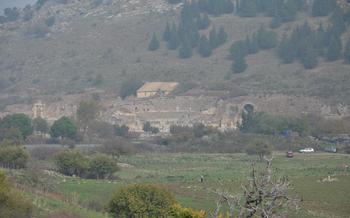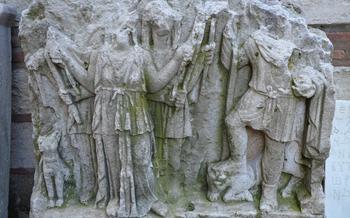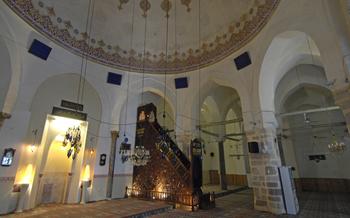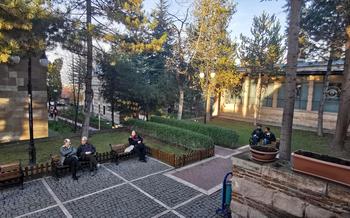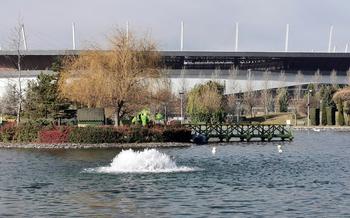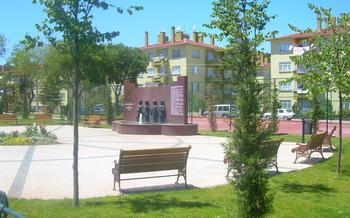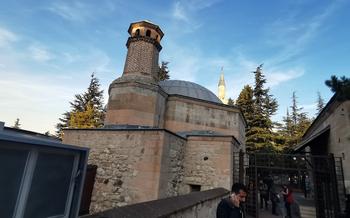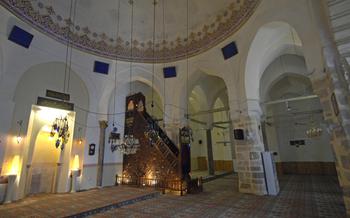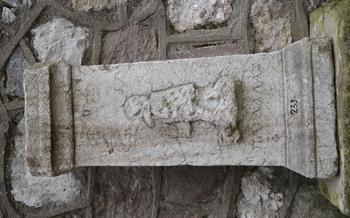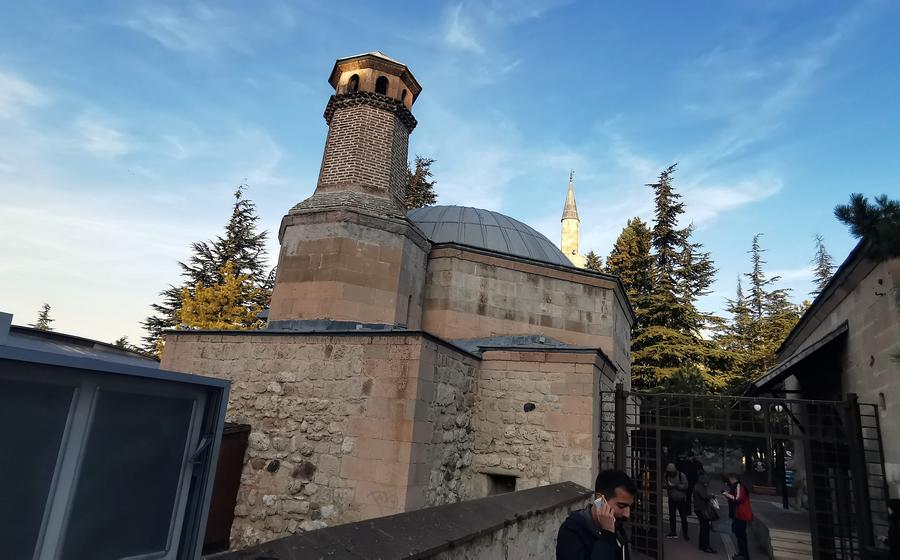
Museum of Karun Treasures
- The Museum of Karun Treasures: A Journey Through History
- Unveiling the Secrets of the Lydian Civilization
- Treasures of Ancient Gold: A Visual Extravaganza
- Unraveling the Mystery of the Royal Hoard
- Stepping into the Past: Interactive Exhibits and Displays
- A Journey Through Time: The Museum's Collections
- Uncovering the Lydian Legacy: Beyond the Treasures
- A Unique Perspective: The Museum's Architecture
- The Soul of Eskişehir: A Vibrant Cultural Hub
- Practical Information: Planning Your Visit
- Engaging the Senses: Museum Activities and Workshops
- A Bridge Between Past and Present: Modern Interpretations of Lydian Art
- Preservation and Conservation: Protecting the Treasures
- Unforgettable Souvenirs: The Museum Shop
- Insider Tip: Unveiling Hidden Gems
The Museum of Karun Treasures: A Journey Through History
In the heart of Eskişehir, a city brimming with history and culture, lies a treasure trove that transports visitors back in time to the ancient world: the Museum of Karun Treasures. This remarkable institution houses a collection of priceless artifacts that have shed new light on the enigmatic Lydian civilization, once a powerful kingdom that flourished in Western Anatolia.
The museum's journey begins with a captivating introduction to the historical context of the Karun Treasures, discovered in 1966 by a local farmer in the village of Karun. This extraordinary find, comprising over 1000 pieces of gold jewelry, coins, and ornaments, revolutionized our understanding of Lydian culture and craftsmanship.
The significance of the Karun Treasures extends beyond their intrinsic beauty and monetary value. They serve as a testament to the Lydians' mastery of metallurgy and their sophisticated artistic traditions. The intricate designs and symbolism depicted on these artifacts offer valuable insights into the daily lives, beliefs, and practices of this ancient civilization.
As visitors navigate the museum's well-curated exhibition galleries, they are immersed in the splendor and artistry of the Lydian era. The layout of the museum allows for an in-depth exploration of Lydian history and culture, providing a comprehensive understanding of this once-great kingdom.
Unveiling the Secrets of the Lydian Civilization
The Museum of Karun Treasures offers a unique opportunity to delve into the fascinating history of the Lydian Kingdom, which played a significant role in shaping the ancient world. Eskişehir, where the museum is located, was once a prominent Lydian city, and the discovery of the Karun Treasures has shed new light on the culture, craftsmanship, and daily lives of this ancient civilization.
The Lydians, who ruled over western Anatolia from the 7th to the 6th century BC, were renowned for their wealth, power, and cultural achievements. They established a vast trading network that spanned from the Aegean Sea to the Persian Empire, and their capital, Sardis, was one of the most prosperous cities in the ancient world.
The Karun Treasures, discovered in 1966 by a farmer named Karun, provide valuable insights into the Lydian civilization. The hoard consists of over 400 gold and silver artifacts, including jewelry, coins, and ornaments, all exquisitely crafted and adorned with intricate designs. These treasures offer a glimpse into the artistry, craftsmanship, and wealth of the Lydian people.
Visitors to the museum can explore the various galleries dedicated to the Lydian civilization, where they can learn about the kingdom's history, culture, and economy. Interactive displays and multimedia presentations bring the Lydian world to life, allowing visitors to experience the sights and sounds of this ancient civilization.
Treasures of Ancient Gold: A Visual Extravaganza
As you wander through the museum's galleries, prepare to be dazzled by the stunning collection of gold artifacts that narrate the Lydian civilization's opulence and artistry. Exquisite jewelry, meticulously crafted coins, and elaborate ornaments shimmer under the museum's lights, showcasing the Lydians' mastery of goldsmithing.
The intricate designs and symbolism of these treasures offer a glimpse into the Lydians' cultural identity and beliefs. From delicate necklaces adorned with intricate filigree to majestic bracelets featuring mythical creatures, each piece tells a story of a vibrant and sophisticated society.
The Karun Treasures stand out for their exceptional craftsmanship and the sheer quantity of gold they contain, highlighting the Lydians' wealth and power. The museum also displays gold artifacts from other ancient civilizations, allowing visitors to compare and contrast the Lydian style with that of their contemporaries.
These treasures serve as testaments to the Lydians' exceptional skills in metallurgy, their mastery of intricate techniques, and their ability to transform gold into objects of both beauty and value.
Unraveling the Mystery of the Royal Hoard
The story of the Karun Treasures' discovery is shrouded in intrigue and mystery. According to legend, a shepherd named Karun stumbled upon a cave filled with gold coins and artifacts while tending his flock on Mount Sardis. Intrigued by his discovery, Karun returned to the cave with his friends and family, who helped him excavate the treasure.
The discovery of the Karun Treasures caused a sensation in the archaeological world, and scholars have been debating their origin and significance ever since. Some believe that the treasure was buried by King Croesus, the last king of Lydia, to protect it from invading Persian armies. Others suggest that it was a royal treasury that was hidden during a time of political turmoil.
Whatever its origin, the Karun Treasures offer a glimpse into the wealth and opulence of the Lydian Kingdom. The hoard includes stunning gold jewelry, coins, and ornaments, as well as silver and bronze vessels. The artifacts are intricately crafted and feature intricate designs, demonstrating the Lydians' mastery of metallurgy and craftsmanship.
The mystery surrounding the Karun Treasures continues to fascinate visitors to the Museum of Karun Treasures. Through ongoing research and archaeological investigations, experts are working to unravel the secrets of this remarkable discovery and shed light on the history of the ancient Lydian civilization.
Stepping into the Past: Interactive Exhibits and Displays
The Museum of Karun Treasures offers an immersive experience that goes beyond the mere display of artifacts. Interactive exhibits and multimedia presentations bring the past to life, allowing visitors to engage with Lydian culture on a deeper level. Virtual reality tours transport visitors to ancient Lydian sites, offering an immersive exploration of the city's ruins and landmarks. Hands-on activities and workshops provide a unique opportunity to learn about Lydian crafts, jewelry-making, and other aspects of their daily lives. Educational programs and resources cater to students and researchers, facilitating a deeper understanding of Lydian history and culture. Through these interactive elements, the museum creates a dynamic and engaging environment that fosters a personal connection with the past.
A Journey Through Time: The Museum's Collections
The Museum of Karun Treasures is home to a diverse array of artifacts that provide a glimpse into the region's rich history. In addition to the renowned Karun Treasures, the museum houses notable collections of ceramics, sculptures, and inscriptions.
The ceramic collection showcases a variety of vessels, from utilitarian pottery to intricately decorated plates and bowls. These artifacts offer insights into the daily lives of the Lydian people, revealing their culinary practices, trade networks, and artistic preferences.
The museum's sculpture collection includes impressive stone and bronze statues depicting gods, goddesses, and mythological creatures. These sculptures provide a glimpse into the religious beliefs and artistic traditions of the Lydians.
The collection of inscriptions, including stelae and tablets, offers valuable historical information. These inscriptions shed light on the political, economic, and social structures of the Lydian Kingdom, as well as their interactions with neighboring civilizations.
Together, these diverse collections provide a comprehensive overview of Lydian culture and history, allowing visitors to explore the region's artistic achievements, religious practices, and economic development.
Uncovering the Lydian Legacy: Beyond the Treasures
The Lydian civilization's influence extended far beyond the confines of its kingdom. Their cultural legacy permeated Anatolia, shaping the region's art, architecture, and economic systems. Lydian art, with its distinctive style and motifs, influenced subsequent civilizations, including the Romans and Byzantines. Their architectural innovations, such as the use of vaulted ceilings and columns, were adopted and refined by later builders.
In the realm of commerce, the Lydians introduced a standardized coinage system, revolutionizing trade and economic exchange. Their coins, featuring the iconic lion and bull motif, became widely accepted throughout the ancient world. The Lydians' proficiency in metallurgy and goldsmithing contributed to their economic success, as they produced exquisite jewelry, ornaments, and other luxury goods that were highly sought after.
The Lydians' contributions to trade and commerce were instrumental in facilitating cultural exchange and fostering economic development throughout the region. Their legacy continues to resonate in modern Turkey, where the spirit of entrepreneurship and trade remains a vital part of the country's identity.
The Museum of Karun Treasures serves as a testament to the enduring legacy of the Lydian civilization. By preserving and showcasing the treasures unearthed from the ancient city of Sardis, the museum offers a glimpse into the rich cultural heritage of a people who left an indelible mark on the history of Anatolia.
A Unique Perspective: The Museum's Architecture
The Museum of Karun Treasures stands out not only for its exceptional collection but also for its striking modern architecture. Designed by renowned Turkish architect Emre Arolat, the building seamlessly blends contemporary design with traditional elements, creating a harmonious dialogue between past and present. The museum's facade, adorned with a captivating geometric pattern inspired by Lydian motifs, hints at the treasures within.
Upon entering, visitors are greeted by a spacious and well-lit atrium, which serves as the central axis of the museum. The use of glass and natural light creates a sense of transparency, allowing visitors to glimpse the various exhibition galleries from different vantage points. The interior design echoes the museum's theme, incorporating subtle references to Lydian culture through the use of materials, colors, and textures.
The museum's galleries are arranged in a logical flow, guiding visitors through the different aspects of Lydian history and culture. Each gallery features unique architectural elements that complement the exhibits, creating immersive and engaging spaces. The use of interactive displays and multimedia presentations further enhances the visitor experience, allowing them to delve deeper into the world of the Lydians.
Beyond its functional purpose, the museum's architecture is a work of art in its own right. Arolat's innovative design has garnered international acclaim, earning the museum numerous awards and accolades. The building has become a symbol of Eskişehir's cultural vibrancy and a must-see destination for architecture enthusiasts.
The Soul of Eskişehir: A Vibrant Cultural Hub
Eskişehir, the home of the Museum of Karun Treasures, is not just a treasure trove of ancient artifacts but also a vibrant cultural hub that pulses with creativity and innovation. Renowned for its lively art scene, Eskişehir boasts a plethora of museums, galleries, and cultural institutions that showcase a diverse range of artistic expressions.
The city's reputation as a center of culture and education is further cemented by the presence of prestigious universities and institutions, attracting a large student population that contributes to the city's youthful and dynamic atmosphere. Eskişehir's streets are adorned with colorful murals and graffiti, reflecting the city's vibrant street art culture, while its many theaters and music venues host a variety of performances, from traditional Turkish music to contemporary international acts.
Beyond its artistic offerings, Eskişehir is also a city that embraces its rich history and cultural heritage. Visitors can delve into the city's past at the Eskişehir Archeological Museum, which houses a collection of artifacts from various periods, including the Phrygian, Roman, and Ottoman eras. The city's many historical sites, such as the Odunpazarı district, offer a glimpse into the architectural and cultural legacy of Eskişehir.
With its blend of traditional and contemporary culture, Eskişehir offers visitors a unique and immersive experience. Whether you're an art enthusiast, a history buff, or simply seeking a vibrant and welcoming atmosphere, Eskişehir has something to offer everyone.
Practical Information: Planning Your Visit
The Museum of Karun Treasures is conveniently located in the heart of Eskişehir, making it easily accessible for visitors.
Engaging the Senses: Museum Activities and Workshops
The Museum of Karun Treasures offers a range of educational programs, workshops, and activities that provide visitors with hands-on experiences and deeper insights into Lydian culture. These activities are designed to engage all senses and make learning about history fun and interactive.
Popular workshops focus on traditional crafts, jewelry-making, and ancient Lydian techniques. Participants can learn the art of metalworking, creating intricate jewelry pieces inspired by Lydian designs, or try their hand at weaving or pottery using traditional methods. These workshops are led by skilled artisans who share their knowledge and expertise with participants.
Families and groups seeking interactive and engaging learning experiences will find plenty to enjoy at the museum. There are scavenger hunts that lead visitors on a journey of discovery through the galleries, uncovering hidden treasures and learning about Lydian history along the way. Children can also participate in storytelling sessions that bring Lydian legends and myths to life.
The museum's educational programs are designed to cater to different age groups and interests. School groups can book guided tours and workshops that align with their curriculum, while adults can participate in lectures, seminars, and hands-on workshops that delve deeper into specific aspects of Lydian culture and history.
Through these engaging and interactive activities, the museum aims to foster a deeper appreciation for Lydian heritage and provide visitors with a truly immersive and memorable experience.
A Bridge Between Past and Present: Modern Interpretations of Lydian Art
The Museum of Karun Treasures is not just a repository of ancient artifacts; it also serves as a bridge between the past and the present through its promotion of contemporary art inspired by Lydian culture. The museum regularly hosts exhibitions and installations showcasing modern interpretations of Lydian motifs and techniques by talented artists and designers. These contemporary works breathe new life into ancient traditions, demonstrating the enduring influence of Lydian art and culture.
One striking example is the "Lydian Echoes" exhibition, which featured a collection of paintings and sculptures inspired by Lydian mythology and iconography. The artists drew upon the rich visual language of Lydian art to create works that were both modern and deeply rooted in the past. Another highlight was the "Goldsmithing Revived" workshop, where participants learned traditional jewelry-making techniques and created their own pieces inspired by Lydian designs.
Through these initiatives, the Museum of Karun Treasures fosters a dynamic dialogue between ancient and contemporary art, showcasing how Lydian heritage continues to inspire and shape creative expression. Visitors are encouraged to explore these modern interpretations alongside the ancient treasures, gaining a deeper appreciation for the enduring legacy of Lydian culture.
Preservation and Conservation: Protecting the Treasures
The Museum of Karun Treasures is committed to preserving and conserving the invaluable artifacts in its collection, ensuring their legacy for future generations. The museum's conservation team works diligently to protect the treasures from the ravages of time, employing state-of-the-art techniques and collaborating with experts in the field.
Preserving ancient artifacts presents unique challenges, as they are often delicate and susceptible to environmental factors. The museum's conservation team carefully monitors temperature, humidity, and light levels to create an optimal environment for the artifacts' preservation. They also utilize specialized techniques such as restoration, cleaning, and stabilization to address damage and prevent further deterioration.
The museum collaborates with universities, research institutions, and international organizations to stay at the forefront of conservation practices. Through these partnerships, the museum gains access to cutting-edge technologies and expertise, ensuring the most effective preservation methods are employed.
Preserving cultural heritage is not just a technical endeavor; it is a commitment to safeguarding the collective memory of humanity. The Museum of Karun Treasures recognizes the importance of this responsibility and strives to ensure that the treasures entrusted to its care remain a source of knowledge, inspiration, and wonder for generations to come.
Unforgettable Souvenirs: The Museum Shop
The Museum of Karun Treasures offers a unique opportunity to take home a piece of Lydian history through its well-curated museum shop. Here, visitors can find an array of souvenirs and mementos that celebrate the rich cultural heritage of the Lydian civilization.
From exquisite replicas of Lydian jewelry and coins to intricately designed pottery and sculptures, the museum shop offers a wide selection of authentic and high-quality souvenirs. These replicas are meticulously crafted by skilled artisans, ensuring that each piece captures the essence and beauty of the original artifacts.
In addition to replicas, the museum shop also features a collection of books and publications that delve into the history, culture, and archaeology of the Lydian civilization. These publications provide valuable insights into the Lydian way of life, their artistic achievements, and their contributions to ancient Anatolia.
By purchasing souvenirs from the museum shop, visitors not only take home a tangible reminder of their visit but also contribute to the preservation and promotion of Lydian culture. The revenue generated from the museum shop supports the museum's ongoing conservation efforts, educational programs, and research initiatives.
For those seeking unique and meaningful souvenirs, the museum shop also offers a selection of locally-crafted items inspired by Lydian art and motifs. These handmade pieces, created by local artisans, showcase the vibrant contemporary interpretations of Lydian heritage.
Whether you're looking for a special gift for a loved one or a memento to commemorate your visit, the Museum of Karun Treasures' shop offers an array of authentic and memorable souvenirs that will transport you back to the ancient world of Lydia.
Insider Tip: Unveiling Hidden Gems
As you wander through the Museum of Karun Treasures, keep an eye out for secret spots that offer unique perspectives and lesser-known artifacts. One such spot is the dimly lit corner on the lower level, where you'll find a small display of Lydian jewelry that has been painstakingly reconstructed from fragments. These delicate pieces, often overlooked by visitors, offer a glimpse into the exquisite craftsmanship of the Lydian goldsmiths.
Beyond the museum walls, Eskişehir is brimming with hidden gems waiting to be discovered. Venture off the beaten path and explore the narrow cobblestone streets of the Old Town, where you'll find charming cafes, art galleries, and boutiques showcasing local crafts. Don't miss the historic Odunpazarı district, with its well-preserved Ottoman-era houses and workshops.
For a taste of authentic Turkish cuisine, head to the local markets where you can sample fresh produce, traditional sweets, and savory street food. Engage with the friendly locals, learn about their customs, and immerse yourself in the vibrant culture of Eskişehir. This city is a treasure trove of hidden delights, just waiting to be unearthed. Embrace the spirit of discovery and let Eskişehir unveil its secrets to you.
